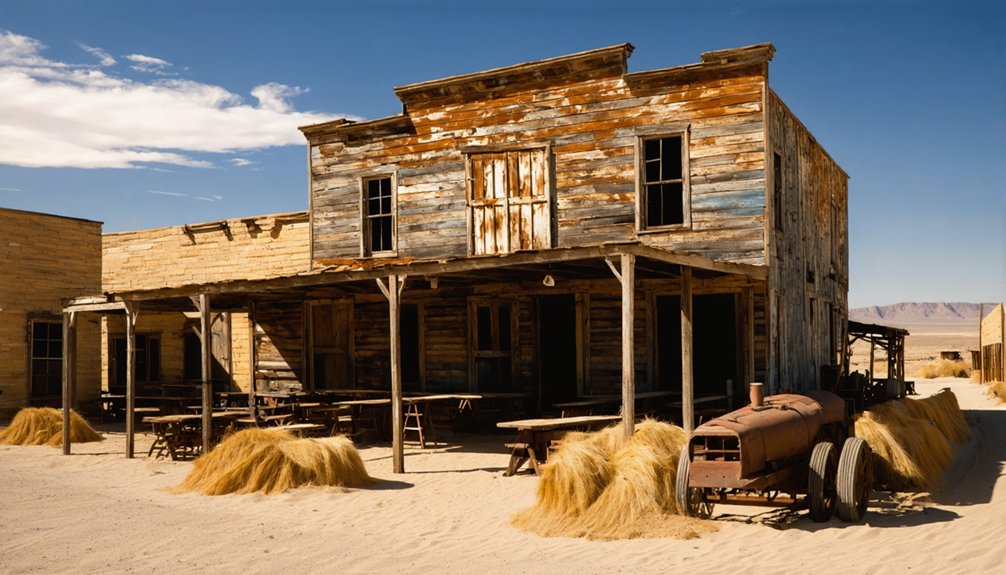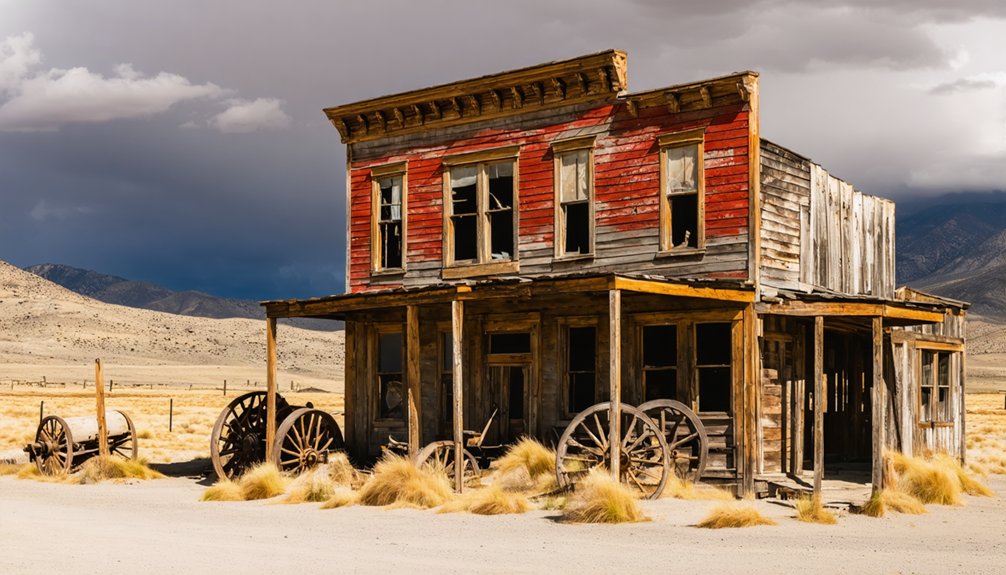Ghost towns emerge when communities face multiple challenges that force residents to leave. You’ll find these abandoned places result from depleted natural resources (like exhausted mines), devastating natural disasters, or economic isolation due to transportation changes. Wars and political upheaval can also drive mass evacuations, while demographic shifts from rural to urban areas steadily drain populations. Environmental threats like rising seas and underground fires create additional pressures. These complex factors reveal fascinating stories of community collapse and abandonment.
Key Takeaways
- When natural resources like gold or oil are depleted, towns built around these industries often fail without economic diversification.
- Natural disasters and environmental catastrophes, including floods, volcanic eruptions, and nuclear accidents, force permanent evacuation of communities.
- Changes in transportation routes, especially railway closures and highway bypasses, isolate towns and trigger business closures.
- War damage, political instability, and military base closures can devastate local economies and cause mass population exodus.
- Rural-to-urban migration depletes small town populations, while aging demographics and limited services accelerate community decline.
The Impact of Resource Depletion on Town Survival
While natural resources initially attract settlers and drive rapid urban development, their eventual depletion often leads to the dramatic decline and abandonment of resource-dependent towns.
You’ll find that towns relying heavily on single resource extraction become particularly vulnerable when that resource runs dry or becomes unprofitable to mine.
Resource dependency creates a precarious situation where your town’s survival hangs on one industry’s success. Without economic diversification during the boom years, these communities can’t sustain themselves once the primary resource is gone.
The transformation of Bodie, California, from a bustling city of gold mining powerhouse to an empty shell exemplifies this pattern of decline.
You’ll notice this especially in remote locations, where towns operate as satellites to larger hubs. The educated youth often leave first, seeking opportunities elsewhere, while the remaining population struggles as jobs disappear and services decline. Nevada’s boom town decline demonstrates this pattern with over six hundred ghost towns across the state.
Only towns that successfully develop alternative industries during their resource boom tend to survive.
Natural Disasters and Environmental Catastrophes
Throughout history, natural disasters and environmental catastrophes have emerged as powerful forces that can rapidly transform thriving communities into ghost towns.
You’ll find that flooding from dam projects has submerged entire towns like Tignes, France, while volcanic eruptions have obliterated settlements such as New Zealand’s Te Wairoa. Nuclear disasters have created some of the most dramatic examples, with Chernobyl’s incident forcing the abandonment of nearly 200 towns.
You can’t ignore how extreme weather events and climate changes drive people from their homes, as seen in communities devastated by persistent droughts or storms. In cases like Times Beach, Missouri, dioxin contamination forced residents to permanently evacuate their homes.
Whether it’s earthquakes triggering devastating landslides, toxic industrial accidents like Centralia’s underground fire, or flood-prone areas experiencing repeated inundation, these environmental catastrophes often render locations permanently uninhabitable, leaving behind empty shells of once-vibrant communities.
In the United States alone, 46 ghost towns lie underwater, particularly in Pennsylvania, serving as stark reminders of how water management projects can permanently alter landscapes.
Transportation Changes and Economic Isolation
You’ll find that many ghost towns emerged when railway lines were rerouted or discontinued, cutting off essential economic lifelines that once sustained thriving communities.
When highways bypassed previously well-connected towns, businesses shuttered as traffic patterns shifted away, leaving local economies to wither.
The disruption of supply chains through lost transportation access created a ripple effect, where increased operating costs drove away industries and sparked mass exodus from these isolated communities. Modern cities like Cincinnati demonstrate this pattern, as their abandoned concourse at the international airport reflects diminishing transportation connectivity.
This pattern played out in Terry County’s Gomez settlement, where the town’s decline began after the South Plains Railway favored nearby Brownfield instead.
Railway Decline Effects
As railroads declined across America during the 20th century, their abandonment triggered profound and lasting economic isolation in affected communities.
You’ll find that when rail access disappeared, populations shrank by 3% compared to areas that maintained their rail connections. The impact wasn’t just temporary – these changes reshaped entire regions permanently.
- High-skilled workers and young professionals fled first, leaving behind aging populations.
- Farmers lost $20.5 million in income due to increased transportation costs.
- Rural communities saw their market options shrink to local truck-served territories.
- Small towns located far from remaining rail lines suffered the deepest economic decline.
The Great Depression era devastated many rail-dependent towns as their business customers failed, intensifying the isolation of these communities.
Branch line abandonment accelerated through the 1970s as railroads merged and eliminated unprofitable routes, further devastating rural economies.
Without rail infrastructure, these communities couldn’t compete with well-connected regions, leading to a downward spiral of job losses, population decline, and diminished economic opportunities.
Highway Bypass Impact
When highways bypass small towns, they create devastating economic ripples that can transform vibrant communities into struggling settlements.
You’ll find that traffic reductions of up to 72% strike at the heart of local economies, particularly affecting businesses that rely on pass-through customers. Gas stations face steep 15% sales declines, while restaurants, motels, and convenience stores struggle to survive. Clarksdale’s experience exemplifies how devastating these changes can be for local businesses.
The economic isolation caused by highway bypasses triggers a cascade of consequences. Research shows that background economic factors ultimately have more influence on a town’s fate than the bypass itself.
You’ll notice populations dwindling as younger residents leave to seek opportunities elsewhere. Services deteriorate, with full hospitals downgrading to satellite offices.
While the first few years might show minimal overall impact, long-term effects can be severe, especially in smaller communities that can’t diversify their economies or attract new visitors to replace lost highway traffic.
Supply Chain Disruption
Supply chain disruptions can devastate small towns through complex transportation challenges and workforce mobility issues. When transportation networks fail, towns lose their economic resilience and face potential abandonment.
You’ll find these disruptions manifest in various ways that can isolate communities from essential resources and opportunities.
- Workers avoid commuting through unsafe areas, leading to 50% absenteeism rates that cripple local businesses.
- Port congestion and road closures create bottlenecks that prevent goods from reaching isolated communities.
- Natural disasters sever critical transport links, causing businesses to relocate permanently.
- Pandemic-related restrictions interrupt workforce mobility, resulting in extended production shutdowns.
Without reliable supply chains, towns struggle to maintain their economic viability. When businesses can’t receive materials or ship products, they’re forced to close or relocate, leaving communities to fade into ghost towns.
The Role of War and Political Upheaval

Throughout history, warfare and political instability have transformed thriving communities into ghost towns through both direct destruction and indirect consequences.
You’ll find war impacts evident in places like Belchite, Spain, where battle damage left infrastructure beyond repair, and Quneitra, which remains preserved as a war memorial.
Political instability often triggers mass evacuations, as seen in Ochamchire during ethnic cleansing campaigns.
When military priorities shift, entire communities can collapse.
You’ll notice this pattern in places like Babbitt, Nevada, where base closures eliminated the town’s economic foundation.
Post-conflict regime changes frequently disrupt local governance and services, making towns unsustainable.
In many cases, competing factions deliberately destroy communities, while unresolved territorial disputes prevent rebuilding efforts, leaving these places frozen in time.
Demographic Shifts and Population Loss
Major demographic shifts drive the transformation of once-vibrant communities into ghost towns, with population loss occurring through multiple interconnected mechanisms.
You’ll find that population migration flows consistently from rural to urban areas as residents seek better opportunities, while aging workforce patterns accelerate the decline.
- Witness entire counties in Texas’s High Plains hemorrhaging residents, with some towns losing 7% of their population in a single year.
- See urban centers like San Francisco and St. Louis experiencing dramatic population drops of 6-7% through outward migration.
- Watch as Arctic communities decline by up to 70% since the 1990s.
- Observe the stark reality where octogenarians are projected to outnumber children under five by 2:1 by 2100.
These demographic pressures create a downward spiral, as shrinking tax bases reduce services and trigger further exodus.
Environmental Challenges and Climate Effects

As climate change accelerates environmental degradation worldwide, you’ll find a growing number of communities succumbing to devastating natural forces.
Coastal erosion devours shorelines while rising seas swallow entire towns, from Louisiana’s Burrwood to Maryland’s Holland Island.
You’ll witness how water scarcity and desertification impacts force inhabitants to abandon their homes, particularly in hyper-arid regions where oasis communities struggle to survive.
In Arctic regions, permafrost melting destabilizes foundations and infrastructure, making towns like Newtok, Alaska, uninhabitable.
Natural disasters strike with increasing fury – floods wash away villages, hurricanes demolish coastal settlements, and extreme weather patterns render mountain towns obsolete.
These climate change effects aren’t just reshaping landscapes; they’re erasing communities from the map, creating ghost towns where thriving settlements once stood.
Historical Examples of Town Abandonment
During America’s westward expansion, you’ll find numerous examples of once-thriving towns that succumbed to economic collapse and abandonment.
From California to New Jersey, these settlements tell a stark tale of urban decline tied to shifting economic fortunes and environmental challenges.
- Bodie, California transformed from a bustling gold rush hub of 10,000 residents to a silent ghost town by the 1940s.
- Batsto Village, New Jersey’s ironworks supported the Revolutionary War before fading into obscurity.
- St. Elmo, Colorado’s mining booms attracted 2,000 residents until devastating fires and depleted ore sealed its fate.
- Centralia, Pennsylvania’s underground coal fire forced a complete evacuation, leaving behind a haunting reminder of nature’s power.
These towns stand as examples of the temporary nature of prosperity when tied to finite resources or changing circumstances.
Frequently Asked Questions
Can Abandoned Ghost Towns Be Legally Purchased and Restored?
You can legally purchase ghost towns, but you’ll face strict legal restrictions and complex restoration challenges. Before buying, research ownership status, secure proper permits, and assess rehabilitation costs.
What Happens to Property Ownership Rights in Ghost Towns?
You’ll need to verify ownership rights through land records, as property disputes can arise from unclear title histories. Ownership transfers may be complicated by tax liens and preservation laws.
Are There Ghost Towns That Have Successfully Been Revived?
You’ll find numerous ghost towns revived through strategic tourism and culture initiatives. Their revival strategies typically combine community involvement, arts development, heritage preservation, and innovative business approaches to create thriving destinations.
Do Squatters Commonly Inhabit Ghost Towns?
From Detroit to St. Louis, you’ll find squatters making abandoned places their home. In cities with high vacancy rates, they’re establishing ghost town communities despite uncertain squatter rights and legal challenges.
How Do Governments Manage and Protect Historically Significant Ghost Towns?
You’ll find governments protect ghost towns through preservation efforts involving legal designations, site maintenance, funding programs, and partnerships with local organizations to safeguard cultural heritage for future generations.
References
- https://history.howstuffworks.com/history-vs-myth/ghost-towns.htm
- https://westernmininghistory.com/664/what-is-a-ghost-town-wmh-town-classifications-explained/
- https://www.merriam-webster.com/dictionary/ghost town
- https://www.britannica.com/topic/ghost-town
- https://en.wikipedia.org/wiki/Ghost_town
- https://plainenglish.com/lingo/ghost-town/
- https://texashighways.com/culture/history/what-the-heck-is-a-ghost-town/
- https://exhibits.lib.utah.edu/s/ghost-towns/page/Introduction
- https://grokipedia.com/page/Ghost_Town
- https://pmc.ncbi.nlm.nih.gov/articles/PMC9755273/



